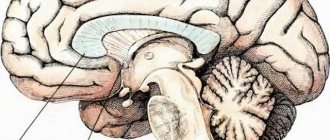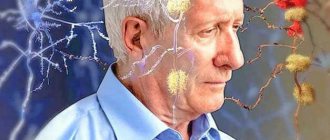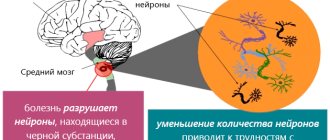Barbiturates
There is a saying that any medicine without proper dosage turns into poison. Barbiturates include barbituric acid, which is addictive when used over a long period of time. Intoxication with barbiturates includes several stages and a difficult period of “coming off”. In order to repeat the past experience of barbiturate intoxication, a person looks for ways to obtain drugs illegally and even goes to theft.
What it is
Barbiturates are a group of drugs containing barbituric acid. Such medications are used for insomnia and exacerbation of certain mental illnesses.
Substances taken orally are absorbed into the small intestine, and when they enter the bloodstream they accumulate in liver cells. This acid causes a disruption in the transmission of nerve impulses, blocks the production of acetylcholine (this causes a sedative effect) and reduces the activity of GABA. Metabolites of active substances accumulate in cells and tissues, leading to intoxication of the body.
Composition of barbiturates
On the official list, about 50 drugs of this group are commercially sold. Barbiturates are synthesized using a combination of urea and dialkylmalonic acid esters. In some cases, urea is mixed with dicyandiamide.
There are ultra-short, short, medium and long-acting drugs. Long-acting medications are most often used for epilepsy.
Formula
Barbituric acid has the formula C4H4N2O3. Self-administration of this group of medications can lead to addiction and serious pathologies of internal organs. It is necessary to know where barbiturates are contained in order to prevent possible negative consequences from use and check the current dosage with your doctor.
List of barbiturates without prescription
When severe insomnia or a panic attack occurs, pharmaceutical drugs based on barbiturates are often used. These include:
- Corvalol (an effective remedy for relieving functional disorders of the cardiovascular system and insomnia. Contains phenobarbital);
- Valocordin (used to relieve cardiac disorders and normalize the functioning of the central nervous system);
- Andipal is a substance for the relief of headaches and migraines, and also has a sedative effect due to the inclusion of phenobarbital.
Self-administration of drugs based on these groups can cause addiction. This means that if insomnia and functional disorders of the cardiovascular system occur, the most successful solution would be to contact a specialist. Before using prescription medications (Barbamyl, Phenobarbital, Amobarbital, etc.), you must read the instructions and follow the dosage.
Effect of barbiturates: effect on the body
This group of drugs has a depressant effect on the nervous system by slowing down the neurotransmitters GABA. The drugs have the following effects:
- Slow reactions and impaired coordination;
- Feeling of euphoria and peace;
- Drowsiness, weakness. Legs become “wobbly”;
- Increased mood, short-term aggressiveness.
After taking the drug, a person experiences a short-term euphoria associated with calmness, and then falls asleep. After waking up, the pupils remain wide, and a painful reaction to light occurs. A migraine, nausea, weakness, and a state of “overwhelm” appear. As addiction develops, abstinence occurs.
Drug use
Barbiturates have a complex effect on the body. The nervous, cardiovascular systems, gastrointestinal tract and even the human brain are involved. Most often, medications are taken enterally (in this case, absorption occurs in the small intestine). Sometimes drugs based on barbituric acid are used intravenously. Once in the bloodstream, the drug is metabolized by liver cells.
Exceeding the recommended dosage of the medication is fraught with the occurrence of acute intoxication. The heart rate slows down, blood pressure drops, consciousness becomes confused, and the person loses consciousness. Failure to provide first aid can result in death.
Time and mechanism of action
When the drug is administered intravenously, the effect occurs rapidly; enteral administration leads to changes in well-being 30-40 minutes after administration. The duration of action of the drug is 3-4 hours.
Are there barbiturates in alcohol?
Alcohol does not contain barbiturates, but the mechanism of action of substances on the central nervous system has similar features. It is important to note that the combined use of alcohol and medications of this group is strictly contraindicated: such a “duet” leads to severe poisoning of the entire body. Even the minimum dosage of the drug, taken together with alcohol, turns into real poison.
Barbiturate drug addicts: pupils, behavior
Barbiturate drug addicts have the following distinctive features:
- Drowsiness and inactivity;
- Lethargy, lethargy;
- Slow speech;
- The addict's eyes are half-closed, his movements are slow;
- Due to bradycardia and hypotension caused by the use of barbiturates, the skin becomes cold;
- The man has an unsteady gait.
An overdose of drugs leads to loss of consciousness. It is necessary to provide timely first aid to a person with addiction. It includes gastric lavage (if the addict is conscious) and calling a team of specialists to the house. In an unconscious state, washing is carried out by a narcologist using a probe.
How do barbiturates affect the nervous system and how is their effect manifested?
Barbiturates are able to interact with the barbiturate-benzodiazepine receptors of the GABA (gamma-aminobutyric acid) neurotransmitter system, which is accompanied by a change in the functioning of sodium-chlorine channels and ultimately a slowdown in the passage of nerve impulses and a decrease in the excitability of nerve cells. The difference in effects between different barbituric acid derivatives lies mainly in their duration and magnitude. This is the basis for the classification of barbiturs into the following groups: • Ultra-short but strong action. For example, secobarbital and pentobarbital act for about 30 minutes; when administered intravenously, they induce drug-induced sleep for 1 minute. • Short- and medium-lasting effect, starting to act after 15-40 minutes and maintaining the effect for 6-8 hours. For example, amobarbital, secobarbital, butabaobital, etc. • With a long-lasting and delayed effect. An example is phenobarbital with a duration of action of 8-10 hours. Used mainly in the treatment of epilepsy. At the present stage, barbiturates are mainly used for premedication (preoperative preparation before general anesthesia) and as an anticonvulsant. Reduced anxiety and normal sleep before surgery are achieved by using high doses of barbiturates. In moderate dosage, they cause a state reminiscent of alcoholic intoxication with euphoria, impaired coordination of movements, clarity of consciousness and intelligibility of speech. When taken systematically, a person loses the ability to learn, concentrate, and his memory also suffers. In addition, by stimulating the vagus nerve, barbiturates can cause severe bronchospasm, which can sometimes be fatal. This is especially true for cases of intravenous administration of sodium thiopental, used for premedication. The main clinical manifestations caused by drugs in this group are reduced to the following physiological effects: • Sedative. • Sleeping pills. • Muscle relaxant. • Anticonvulsant. • Narcotic. • Antiphobic (anxiolytic, anti-anxiety). • Amnestic (the ability to cause amnesia). By the way, the first barbiturate used for medicinal purposes is barbital, known under the market name Veronal and introduced into medical practice in 1903. After 10 years it was replaced by the stronger Phenobarbital.
Types of barbiturates
Barbiturates can only be purchased with a prescription. This group of drugs is taken to treat insomnia, used before surgery, as anesthesia, etc.
Sodium barbiturate
Pentobarbital sodium is otherwise called “Nembutal”. This drug is used to combat insomnia. It is taken enterally or intravenously. Seconal is a short-acting barbiturate with a pronounced tranquilizing effect.
Tablets: hypnotic barbiturates
The most commonly used drugs as sleeping pills are Secobarbital, Allobarbital, and Barbamil. Medicines make it easier to fall asleep and have a tranquilizing effect, but have many side effects. A strong drug is Barbital (Veronal). Taken in powder form, it induces deep sleep.
Barbituric acid preparations
Barbituric acid substances include Phenobarbital and Cyclobarbital. The drugs have anticonvulsant, sedative and analgesic effects.
Barbiturates for anesthesia
Pentobarbital is used in veterinary practice for anesthesia and euthanasia of animals. Tuinal is a strong hypnotic drug, the composition of which is close to opiates. As a result of the compositional characteristics, this substance causes the rapid formation of drug addiction. Veronal is also considered a strong addictive drug.
How did the use of barbiturates in medicine evolve?
Veronal, which I have already mentioned, was used as a sedative and the first sleeping pill. Barbiturates were first introduced into medical practice in 1903, when barbital received the market name "Veronal". Until 1960, the popularity of barbiturates as anti-anxiety and hypnotic drugs was growing, but then there was a decline in their demand. This was explained by the development of addiction and the formation of drug dependence with their long-term use. Therefore, preference began to be given to safer benzodiazepine drugs with the same therapeutic effect. Read more about nootropic drugs. By the way, the problem of addiction to barbiturates was hushed up for a long time, although doctors have been paying attention to it since the 30s of the last century. At the same time, barbiturate-dependent drug addicts prefer short- or medium-acting barbiturates, such as Seconal, Amytal or Nembutal, figuratively calling them “red devils” or “green dragons” in international drug jargon. In veterinary medicine, the barbiturate pentobarbital is used for analgesia and euthanasia.
Effects of barbiturates
Self-administration of medications is fraught with complications.
Harm to the body
Barbiturate addiction leads to:
- Decrease in intelligence;
- Chronic fatigue;
- Drowsiness, weakness, decreased appetite, and, consequently, dystrophy;
- Changes in habits: a person becomes secretive, apathetic, loses interest in life;
- Serious diseases of the cardiovascular system, frequent infectious diseases occur, pustules appear on the skin, sallow complexion, etc.
Barbiturate overdose
An overdose of medications leads to depression of consciousness, breathing, and heartbeat. Blood pressure drops sharply and there is a risk of death.
Barbiturate poisoning
In case of barbiturate poisoning, immediate medical attention must be provided. The narcology team will rinse the patient’s stomach, use infusion solutions and symptomatic medications.
Analyzes
Phenobarbital-based drugs are particularly popular among drug addicts - Barboval, Corvalol, Valocardine, Ballataminal. These barbiturates have a long half-life and elimination from the body:
- in urine – 2-4 weeks;
- in the blood – up to 7 days;
- in nails and hair – up to 1.5-2 months.
Hydroxybutyrates have a cumulative effect, and the longer the addict takes a dangerous substance, the higher the concentration of metabolites in the biomaterial will be.
Barbiturate addiction
The first symptom of the development of barbiturate addiction is the desire to remain constantly intoxicated. The fact is that drug addiction is associated not only with physical withdrawal, but also with mental factors. This means that barbiturate addiction is a consequence of the inability to cope with experiences without drugs. Treatment at a drug treatment clinic will help address the physical effects of addiction, while rehab will address the root cause of the addiction.
Getting rid of barbituromania
Addiction is a disease that is quite difficult to cure, especially if a person goes to a rehabilitation center at an advanced stage, when complications from internal organs are already developing.
The Svoboda Foundation for the Assistance and Rehabilitation of Addicts in Moscow will help return your loved ones to their family within 28 days. Treatment takes place in three licensed drug treatment clinics, which create the most comfortable living conditions for patients. There can be up to 14 people in a rehabilitation group. There is a yoga room and rooms for psychological relaxation.
Our qualified specialists will provide a free consultation on the first day of your application. We provide assistance strictly confidentially. Thanks to a comprehensive scientific approach, in our medical center you can get rid of addiction forever, even in the most severe cases.
You can sign up for consultation and addiction treatment at the clinic on our website in a special form at the bottom of the page.
Barbiturates - what are they?
The history of the creation of barbiturates dates back to the beginning of the 20th century, it was at that time that the drug Barbital or Veronal was created. By the middle of the last century, drugs containing barbiturates had become very widespread and popular. Thousands of their varieties have been created. However, many of them were addictive, addictive and even fatal. Therefore, in the 70s, drugs were removed from free sale.
Today you are unlikely to buy these drugs without a doctor's prescription. The list of barbiturate drugs that can be purchased without a prescription in pharmacies is quite small. As a rule, these are sedatives such as Glycine, Corvalol, Novopassit, Donormil, Milaxen. All of them can cause drug dependence. But you are unlikely to be able to purchase Phenobarbital, which causes a narcotic effect. However, in Russia there are also underground organizations that sell medicines under the counter. Despite the fact that the government is stopping it, unscrupulous pharmacists and drug dealers even sell barbiture on the Internet.
Refusal to use drugs
It is very difficult to get rid of barbiturate addiction.
The withdrawal syndrome is often stronger than with opium addiction. Within a couple of days after stopping taking the drugs, a person feels anxiety, nausea, suffers from insomnia and convulsions. Epileptic seizures, bronchospasm, or coma may occur. This often leads to death. Psychological disorders are also observed: a person cannot think clearly, suicidal tendencies arise. Therefore, such addiction can only be treated in a medical institution under the supervision of a doctor.
Barbiturates. How to remove it from the body?
Even long-term use of completely harmless Corvalol by heart patients or easily excitable patients leads to the appearance of barbituric acid derivatives in the urine.
Such substances are excreted through the kidneys. The time for complete removal depends on their condition and the overall rate of metabolic processes and internal reactions. Therefore, the answer to how to quickly remove barbiturates from urine is quite simple.
You can drink more water and take diuretics, but it is better to trust a professional narcologist. Call 8 (495) 150-85-96
What to pay attention to
If your loved one is experiencing barbiturate withdrawal, you need to stop it urgently! Poisoned by these medications, he may fall into a coma. Call your doctor quickly! Experts will help residents of Bryansk overcome withdrawal symptoms.
Prompt home visit and urgent cleansing of the body in case of intoxication. The addict will come to his senses in a matter of hours. There is no need to endure withdrawal symptoms; it will only push your loved one to take another dose of barbiturates. Reduce withdrawal symptoms and consider getting treatment in a hospital.
Consequences of long-term use
When taking barbiturates over a long period of time, fatigue appears, attention is depleted, and the ability to concentrate is lost. Intense mental activity becomes difficult for the addict. Performance also decreases—even simple tasks require taking a large dose. The drug addict becomes irritable.
If a person continues to use barbiturates in large dosages, he develops toxic encephalopathy. This manifests itself in a decrease in the speed of thought processes and speech impairment. Another consequence is barbituric dementia. Even the slightest mental effort causes difficulties for patients. Thinking is slow, as is speech. Vocabulary is limited, memory problems are observed.










